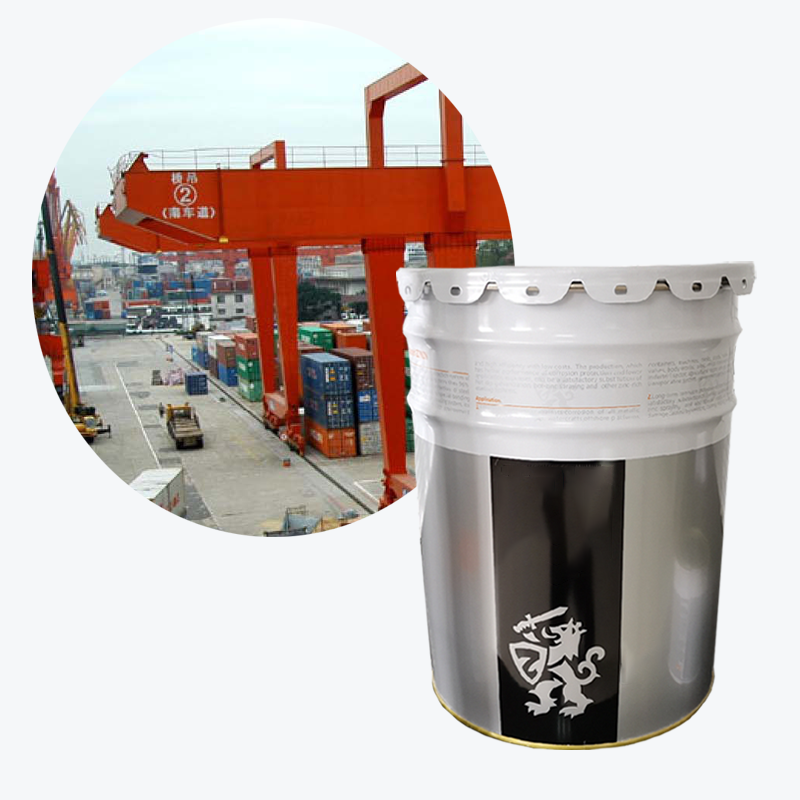A two-component, activated zinc-rich epoxy primer for long term protection of steel in severely corrosive environments
Introduction
Two-component anti-corrosion epoxy zinc primer is composed of epoxy resin, zinc powder, solvent, auxiliary agent and polyamide curing agent.
Features
• Excellent anticorrosive properties
• Provides cathodic protection for locally damaged areas
• Excellent application properties
• Excellent adhesion to blast cleaned carbon steel surfaces
• Zinc dust content 20%,30%,40%,50%,60%,70%,80% are available
Recommended use
As a primer for blast-cleaned bare steel surfaces in moderate to severe corrosive environments, such as steel structures, bridges, port machinery, offshore platforms, construction machinery, storage tanks and pipelines, power facilities, etc., in combination with high-performance paints, which can further improve the anti-corrosion performance of the coating;
Can be used on approved retained zinc-rich shop primer surfaces;
Can be used for repairing damaged areas of galvanized parts or zinc silicate primer coating;
During maintenance, it can only exert its cathodic protection and anti-rust effect on the surface treated to bare steel.
Application Instructions
Applicable Substrate and Surface Treatments:blast cleaned to Sa2.5 (ISO8501-1) or minimum SSPC SP-6, blasting profile Rz40μm~75μm (ISO8503-1) or power tool cleaned to minimum ISO-St3.0/SSPC SP3
Pre-coated workshop primer: Welds, firework calibration and damage should be blasting cleaned to Sa2.5 (ISO8501-1), or power tool cleaned to St3, only approved intact zinc-rich workshop primer can be retained.
Applicable and Curing
• Ambient environment temperature should be from minus 5℃ to 38℃, the relative air humidity should not be more than 85%.
• Substrate temperature during application and curing should be 3℃ above dew point.
• Outdoor application is prohibited in severe weather such as rain, fog, snow, strong wind and heavy dust.
• When the Ambient environment temperature is -5~5℃, low temperature curing products should be used or other measures should be taken to ensure the normal curing of the paint film.
Pot life
| 5℃ | 15℃ | 25℃ | 35℃ |
| 6hrs. | 5hrs. | 4hrs. | 3hrs. |
Application methods
Airless spray/Air spray
Brush and roller coating are only recommended for stripe coat, small area coating or repairing.
During the application process, attention should be paid to frequent stirring to prevent the zinc powder from settling.
Application Parameters
| Application method |
Unit |
Airless spray |
Air spray |
Brush/Roller |
| Nozzle orifice |
mm |
0.43~0.53 |
1.8~2.2 |
—— |
| Nozzle pressure |
kg/cm2 |
150~200 |
3~4 |
—— |
| Thinner |
% |
0~10 |
10~20 |
5~10 |
Drying & Curing
| Substrate surfacetemperature |
5℃ |
15℃ |
25℃ |
35℃ |
| Surface-dry |
4hrs |
2hrs |
1hr |
30mins |
| Through-dry |
24hrs |
16hrs |
12hrs |
8hrs |
| Overcoating Interval |
20hrs |
16hrs |
12hrs |
8hrs |
| Overcoating condition | Before applying the consequent coat, the surface should be clean, dry and free of zinc salts and pollutants | |||
Notes:
–Surface should be dry and free from any contamination
–An interval of several months can be allowed under clean interior exposure condition
–Before overcoating any visible surface contamination must be removed by sand washing, sweep blasting or mechanical cleaning
Preceding & Consequent coating
Preceding coat:Application direct on the surface of steel or hot-dip galvanized or hot-sprayed steel with the surface treatment of ISO-Sa2½ or St3.
Consequent coat:Ferric mica mid coat, epoxy paints, chlorinated Rubber…etc.
Not compatible with alkyd paints.
Packing & Storage
Pack size:base 25kg,curing agent 2.5kg
Flashpoint:>25℃(Mixture)
Storage :Must be stored in accordance with local governmental regulations. The storage environment should be dry, cool, well-ventilated and away from heat and fire sources. The pail must be kept tightly closed.
Shelf life:1 year under good storage conditions from time of production.
Professional technical engineer dedicated to guide you
According to your actual needs, choose the most reasonable overall design and planning procedures
